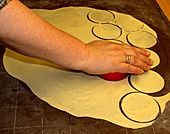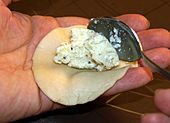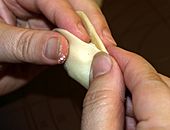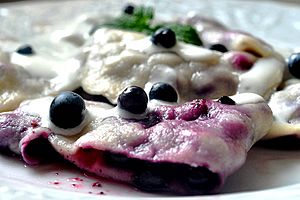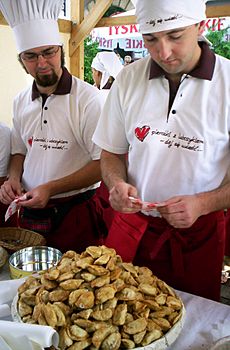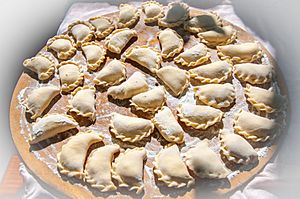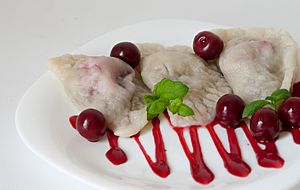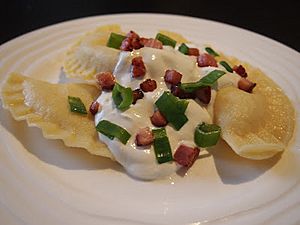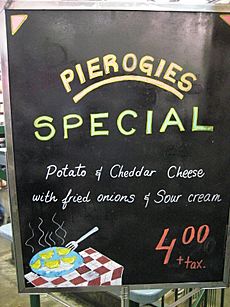Pierogi facts for kids
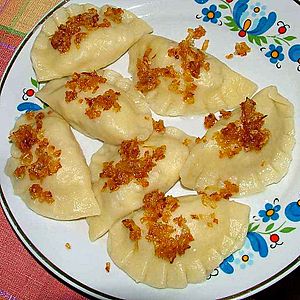
Pierogi ruskie topped with fried onion
|
|
| Alternative names | Perogie, pirogi, pirohy, pyrohy, varenyky, vareniki, peroge |
|---|---|
| Type | Dumpling |
| Course | Appetizer, main, dessert |
| Region or state | Central Europe, Eastern Europe, Southeastern Europe |
| Serving temperature | Warm |
| Main ingredients | Dough: flour, eggs, water Filling: various |
Pierogi are tasty dumplings with a yummy filling inside. They are made by wrapping soft dough around a savory or sweet filling. After being wrapped, pierogi are cooked in boiling water. Sometimes, they are also pan-fried to make them extra crispy before you eat them.
Pierogi are very famous in Central and Eastern European countries. But guess what? They are also super popular in places like America and Canadian cuisine today! In these countries, people might call them by slightly different names.
What can you find inside a pierogi? Lots of things! Common fillings include mashed potatoes, quark (a type of cheese), sauerkraut (fermented cabbage), ground meat, mushrooms, or even fruits. If your pierogi is savory, it often comes with a dollop of sour cream or some fried onions on top. Yum!
Contents
What's in a Name?
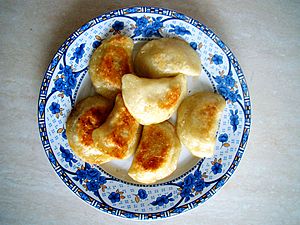
The word "pierogi" comes from Polish. In Polish, pierogi means "filled dumplings." This word comes from an old Slavic word that means "feast." So, pierogi are like a little feast in every bite!
In Ukraine, these dumplings are called varenyky. This name comes from a Ukrainian word that means "boiling liquid." This tells us that boiling is the main way to cook them. You might also hear them called varenikie or wareniki by some Mennonites.
In Slovakia, if you hear bryndzové pirohy, it means dumplings filled with a special sheep milk cheese. In Romania, they are called colțunași. No matter the name, they are all delicious filled dumplings!
Where Did Pierogi Come From?
People often wonder where pierogi first started. The truth is, no one knows for sure! They probably came from somewhere in Central or Eastern Europe a very long time ago. They were eaten in these areas long before countries as we know them today even existed. Now, pierogi are a big part of many cultures in these regions.
One fun story says that in 1238, a person named Hyacinth of Poland visited a town. A big storm ruined all the crops. Hyacinth told everyone to pray, and the next day, the crops grew back! To say thank you, people made pierogi from those crops for Saint Hyacinth. Another story says Saint Hyacinth fed people pierogi during a famine in 1241. Some even think pierogi came from Asia through the Silk Road with explorers like Marco Polo. But these are just legends, and there's no real proof!
Making Pierogi: Ingredients and Steps
Delicious Fillings
Pierogi can be filled with so many yummy things! You can find them with mashed potatoes, fried onions, quark or farmer cheese, cabbage, sauerkraut, meat, mushrooms, spinach, or other cheeses. It just depends on what the cook likes!
For a sweet treat, pierogi can be filled with sweetened quark or fresh fruits like cherry, strawberry, raspberry, blueberry, apple, or plum. Sometimes, even jam is used! To make the dough extra light and tasty, some people add sour cream to it.
How to Prepare Pierogi
First, the dough is made by mixing flour and warm water. Sometimes an egg is added too. This dough is rolled out flat. Then, it's cut into squares with a knife or circles using a cup or drinking glass. Some people add mashed potato to the dough to make it super smooth.
Next, the filling goes in the middle of each dough piece. The dough is then folded over to make a half-circle, rectangle, or triangle. The edges are pressed together very tightly to seal the pierogi. This makes sure the filling stays inside when it cooks!
The pierogi are then gently boiled until they float to the top. After draining, they can be served right away. Or, they can be fried or baked in butter for extra flavor. You can serve them with melted butter, sour cream, or even small pieces of fried bacon, onions, and mushrooms. Sweet pierogi might be topped with apple sauce, jam, or a fruit preserve called varenye.
Pierogi Around the World
Poland: A National Treasure
Long ago, pierogi were seen as food for farmers. But they became so popular that everyone, even nobles, started loving them! Cookbooks from the 1600s show that pierogi were a main food in Poland. Each holiday even had its own special pierogi! They came in different shapes, fillings, and cooking styles. For example, baked pierogi were a popular Christmas dish, often filled with potatoes, cheese, or mushrooms.
Today, pierogi are a huge part of Polish culture and food. They are even considered the national dish! You can find them sweet, salty, or spicy. At a Pierogi Festival in Kraków, Poland, in 2007, people ate 30,000 pierogi every day!
The most popular type in Poland and North America is pierogi ruskie. These are filled with fresh quark cheese, mashed potatoes, and fried onions. Other popular fillings include ground meat, mushrooms, cabbage, or fruits like strawberries and blueberries.
Sweet pierogi are often served with sour cream mixed with sugar. Savory ones come with bacon bits or fried onions. For Christmas Eve supper, Poles traditionally eat two kinds: one with sauerkraut and dried mushrooms, and tiny ones called uszka (ears) in clear barszcz (beetroot soup).
Ukraine: Varenyky Pride
In Ukraine, varenyky are a beloved national dish. They are eaten every day and are also a special part of holiday meals, like Christmas Eve Supper. The name of the popular Polish pierogi ruskie is linked to an old region called Rus', where Ukrainians came from.
Ukrainians see varenyky as a symbol of their culture. Traditionally, they used fermented milk to make the dough, but today, eggs are more common. Typical Ukrainian fillings include cottage cheese, potato, beans, peas, cabbage, plums, meat, fish, and buckwheat.
Ukrainians usually eat varenyky with sour cream and butter. They might also add fried onions and crispy bacon bits. While often savory, varenyky can be a dessert too, with sweet fillings like sour cherries, blueberries, or sweet cottage cheese.
Varenyky are so loved that there's a yearly festival for them in Ukraine! In 2013, a huge snow monument of a varenyk was even made, trying to get into the Guinness Book of Records!
Long ago, Ukrainians thought varenyky looked like a young moon. They used them in old rituals, like sacrificing cheese varenyky near water springs. Farmers even believed varenyky helped bring a good harvest!
Slovakia: Bryndzové Pirohy
A traditional dish in Slovak cuisine is bryndzové pirohy. These are dumplings filled with salty bryndza cheese mixed with mashed potatoes. They are served with more bryndza (made creamy with milk or sour cream) and topped with bacon or fried onion. In Slovakia, pirohy are shaped like a half-circle.
Along with another dish called bryndzové halušky, bryndzové pirohy are one of Slovakia's national dishes.
United States and Canada: A Popular Treat
When people from Central and Eastern Europe moved to the United States and Canada, they brought pierogi with them. Pierogi are very common in places with many Polish or Ukrainian families, like Cleveland, Chicago, and New York City. At first, pierogi were mostly a family food or found in ethnic restaurants. The first recorded sale of pierogi in America was in Cleveland, Ohio, in 1928.
After World War II, churches often sold freshly cooked pierogi to raise money. By the 1960s, you could find frozen pierogi in most supermarkets in the U.S. and Canada, and they are still there today!
Many towns with European roots celebrate pierogi. Whiting, Indiana, has a "Pierogi Fest" every July. Cleveland, Ohio, has races like the "Slavic Village Pierogi Dash." In Pittsburgh, Pennsylvania, there's a fun "pierogi race" at every Pittsburgh Pirates baseball game. Six people dressed in giant pierogi costumes race each other! In 1993, the town of Glendon, Alberta, in Canada, even built a huge 25-foot (7.6 m) fiberglass pierogi statue with a fork!
The United States has a big market for pierogi because so many people from Central and Eastern Europe settled there. You can find many different flavors in grocery stores, even some new ones like spinach, jalapeño, or chicken to suit American tastes.
Canada also has a large Polish and Ukrainian population, so pierogi (often called "perogies" there) are very common. Canada is the second-biggest market for pierogi after the U.S. You can find frozen pierogi everywhere in Canada, even in big stores. Homemade ones are often filled with mashed potatoes (sometimes with cheese), sauerkraut, or fruit like strawberries or blueberries.
Potato and cheese or sauerkraut pierogi are usually served with butter, sour cream, fried onions, or fried bacon. Some restaurants even deep-fry them!
Lazy Pierogi and Varenyky
Lazy varenyky (in Ukrainian and Russian) or leniwe pyrohy (in Rusyn) are a different kind of dumpling. They are shaped like gnocchi and are made by mixing curd cheese with egg and flour to make a quick dough. This dough is rolled into a long sausage shape, then cut diagonally into small pieces.
These dumplings are quickly boiled in salted water and served with sour cream or melted butter. They are called "lazy" because they are super fast to make, usually taking only 10 to 15 minutes! Unlike regular pierogi, these are solid dumplings, not pockets filled with ingredients. The same dish in Polish cuisine is called lazy pierogi.
Pierogi in Culture
Pierogi even have their own special saying in Poland: "Święty Jacek z pierogami!" (St. Hyacinth and his pierogi!). It's an old Polish way to show surprise, like saying "good grief!"
In Ukrainian stories, varenyky are a symbol of Ukrainian identity. In a poem from 1858, a Russian soldier asks a Ukrainian woman to cook varenyky, but he can't remember the word. The woman pretends not to understand him, showing how important the name is to their culture.
There's also the "Great Pittsburgh Pierogi Race N'at" during Pittsburgh Pirates baseball games. Six people dressed in giant pierogi costumes – like Potato Pete, Jalapeño Hannah, and Cheese Chester – race each other!
Pierogi Monuments
A monument to varenyky was put up in Cherkasy, Ukraine, in 2006. It shows a Ukrainian folk hero eating varenyky with a huge crescent-shaped varenyk behind him.
Another monument to a similar dish was built in Poltava, Ukraine, in 2006. And in 1991, a giant pierogi on a fork was built in Glendon, Alberta, Canada. This statue is 7.6 meters (24.9 feet) tall!
See also
 In Spanish: Pierogi para niños
In Spanish: Pierogi para niños


